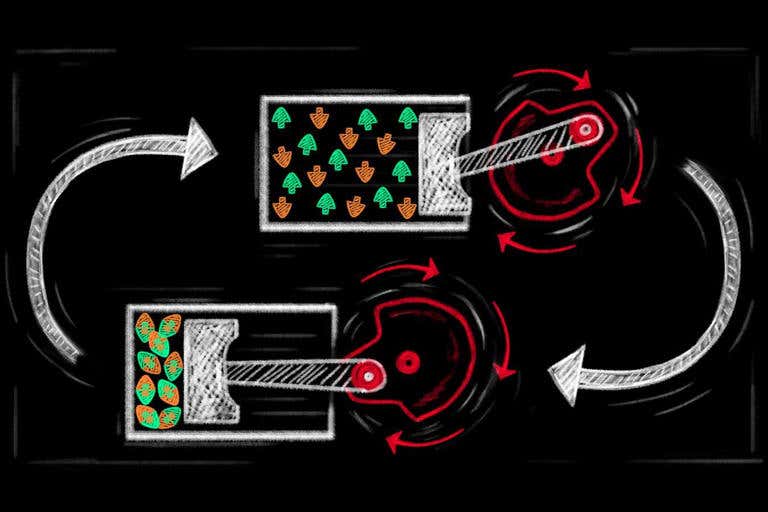Breakthrough quantum engines could revolutionize quantum computing
Researchers have unveiled a pioneering innovation: an engine powered by the constant shifts inherent in the quantum nature of particles.

[Oct. 9, 2023: Staff Writer, The Brighter Side of News]
A quantum engine compresses a gas of bosons and decompresses a gas of fermions. (CREDIT: Mirijam Neve)
In the fast-moving realm of quantum mechanics, researchers have unveiled a pioneering innovation: an engine powered by the constant shifts inherent in the quantum nature of particles.
The promising revelation stands to position quantum engines as potential driving forces behind various quantum technologies in the future.
Understanding the Quantum Ballet of Fermions and Bosons
To lay a foundation for the uninitiated, all known particles in the universe can be bucketed into two categories: fermions or bosons. Their membership in either category greatly influences their behavior when they congregate in sizable clusters.
A crucial experiment led by Artur Widera at the University of Kaiserslautern-Landau in Germany has unveiled an ingenious way to harness this particle behavior.
Related Stories
Widera and his team of physicists have demonstrated a method to craft an engine from a collection of atoms by manipulating their behavior to oscillate between bosonic and fermionic states.
“The difference between the two types of particles is most prominent in the quantum realm, especially at super low temperatures,” notes the research. Thus, the team's prototype was built from a few hundred thousand lithium atoms, which were cooled to an almost unthinkable temperature—a mere hair's breadth from absolute zero.
Crafting Quantum Magic with Magnetic Fields
With the lithium atoms at such frigid temperatures, the researchers capitalized on meticulously calibrated magnetic fields. These fields were the key to toggle the lithium atoms between exhibiting behaviors reminiscent of a congregation of fermions or, upon being induced to form molecule-like pairs, a group of bosons.
Principles of the quantum Pauli engine. Schematic of the experimental set-up. The atom cloud (purple ellipsoid) is trapped in the combined fields of a magnetic saddle potential (orange surface) and an optical dipole trap potential (blue cylinder) operating at a wavelength of 1,070 nm. (CREDIT: Nature)
The process began with an assembly of boson-mimicking paired-up atoms. By compressing these atoms and subsequently converting them into fermions, their collective energy surged. Following this, Widera's team allowed the atoms to expand, while also readjusting the magnetic fields to reshape the atomic pairs, turning them back to boson-like states. This maneuver reduced their overall energy.
Essentially, the gap in energy between these maneuvers became the work output of this innovative ultracold atom engine. Analogous to the “working fluid” in traditional engines, the researchers extracted work through a repetitive cycle of atom compression and expansion.
Professor Artur Widera (right) with Jennifer Koch (first author of the study, left) and Sian Barbosa (center), both from his research group, and Dr. Eloisa Cuestas, (co-author from Okinawa, front). (CREDIT: RPTU/Koziel)
"At present, our engine boasts an efficiency rate hovering around 25 per cent," Widera remarked. But he radiates optimism, believing that with refinements, the efficiency can be bolstered. “While we're not envisioning powering the next generation of luxury vehicles with a quantum engine, our experiment is a landmark. We've illustrated that an engine can indeed be driven by a purely quantum form of energy,” he added.
Charting New Terrains in Quantum Mechanics
The experimental engine not only signifies a quantum leap in harnessing quantum properties but also offers a fresh perspective. As Sebastian Deffner from the University of Maryland, Baltimore County, illuminates, “The differential behavior of fermions and bosons is inherently a quantum property. Such a phenomenon is virtually untappable using conventional machinery, making this engine a truly unique invention. The potential of this distinct quantum resource is vast, and it's pivotal for us to investigate its technological applications."
Contribution of the Pauli energy. Trap energy variation ΔU as a function of the number of atoms in a single spin state NiA for the magnetic field change between cycle points B → C for a gas performing a Pauli stroke (bringing the gas from a molecular BEC to a unitary gas, cyan), a Feshbach stroke (always remaining in the molecular BEC regime, orange) and a thermal stroke for the same magnetic fields as in the Pauli stroke (red). (CREDIT: Nature)
Echoing this sentiment, Gabriele De Chiara from Queen’s University Belfast in the UK envisions a future wherein quantum engines could play a pivotal role. "If these engines evolve to be more practical, they could serve as chargers for other quantum devices like quantum batteries,” De Chiara says. He further speculates about the possibility of employing these engines “in reverse”. This would involve utilizing quantum engines to cool gadgets like quantum computers, which are notoriously more error-prone when operating at elevated temperatures.
The world stands at the precipice of a quantum revolution. With innovations like Widera's quantum engine, the promise of harnessing quantum properties for practical, technologically-advanced applications is closer than ever. As the realms of theoretical physics and applied mechanics converge, the next chapter in the story of human innovation is set to be an exciting one, powered by the dance of nature's tiniest particles.
For more science and technology news stories check out our New Innovations section at The Brighter Side of News.
Note: Materials provided above by The Brighter Side of News. Content may be edited for style and length.
Like these kind of feel good stories? Get the Brighter Side of News' newsletter.



